Strategic Marketing: Macro-Environmental Analysis, Market Entry Modes, Segmentation and Targeting
VerifiedAdded on 2022/11/28
|12
|4162
|116
AI Summary
This project focuses on strategic marketing and explores macro-environmental analysis, modes of market entry, and concepts of segmentation and targeting. It aims to help organizations gain a competitive advantage in the market.
Contribute Materials
Your contribution can guide someone’s learning journey. Share your
documents today.
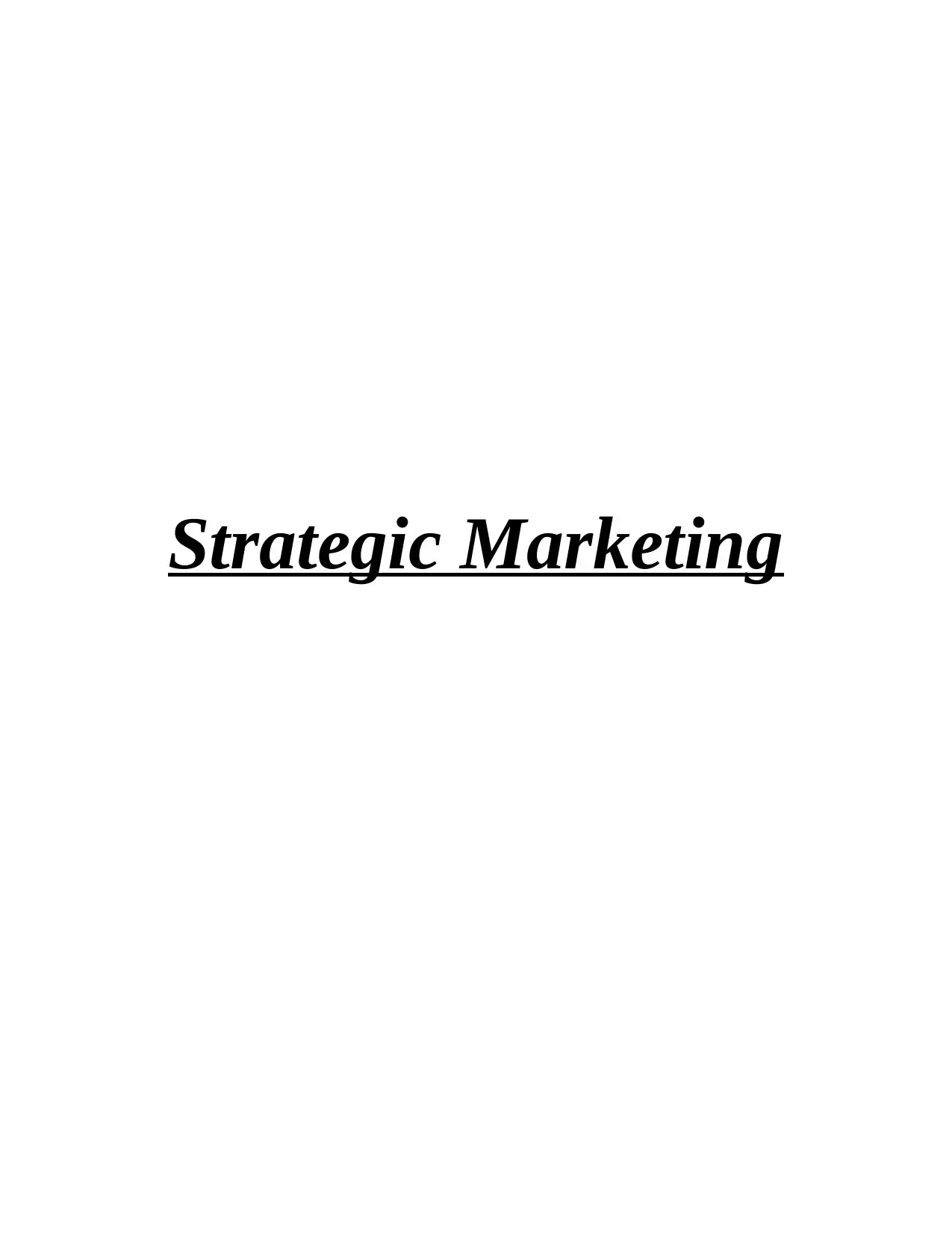
Strategic Marketing
Secure Best Marks with AI Grader
Need help grading? Try our AI Grader for instant feedback on your assignments.
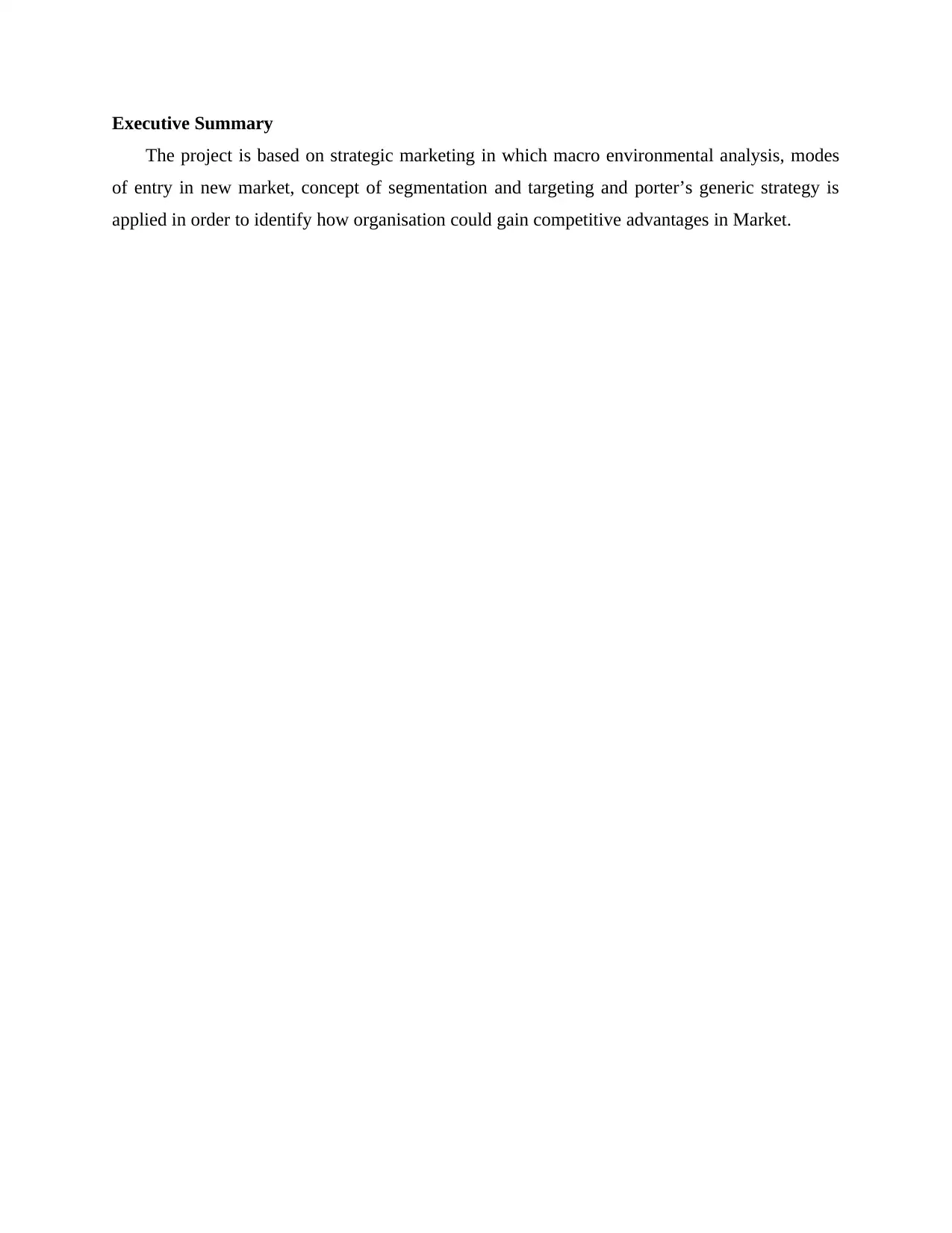
Executive Summary
The project is based on strategic marketing in which macro environmental analysis, modes
of entry in new market, concept of segmentation and targeting and porter’s generic strategy is
applied in order to identify how organisation could gain competitive advantages in Market.
The project is based on strategic marketing in which macro environmental analysis, modes
of entry in new market, concept of segmentation and targeting and porter’s generic strategy is
applied in order to identify how organisation could gain competitive advantages in Market.
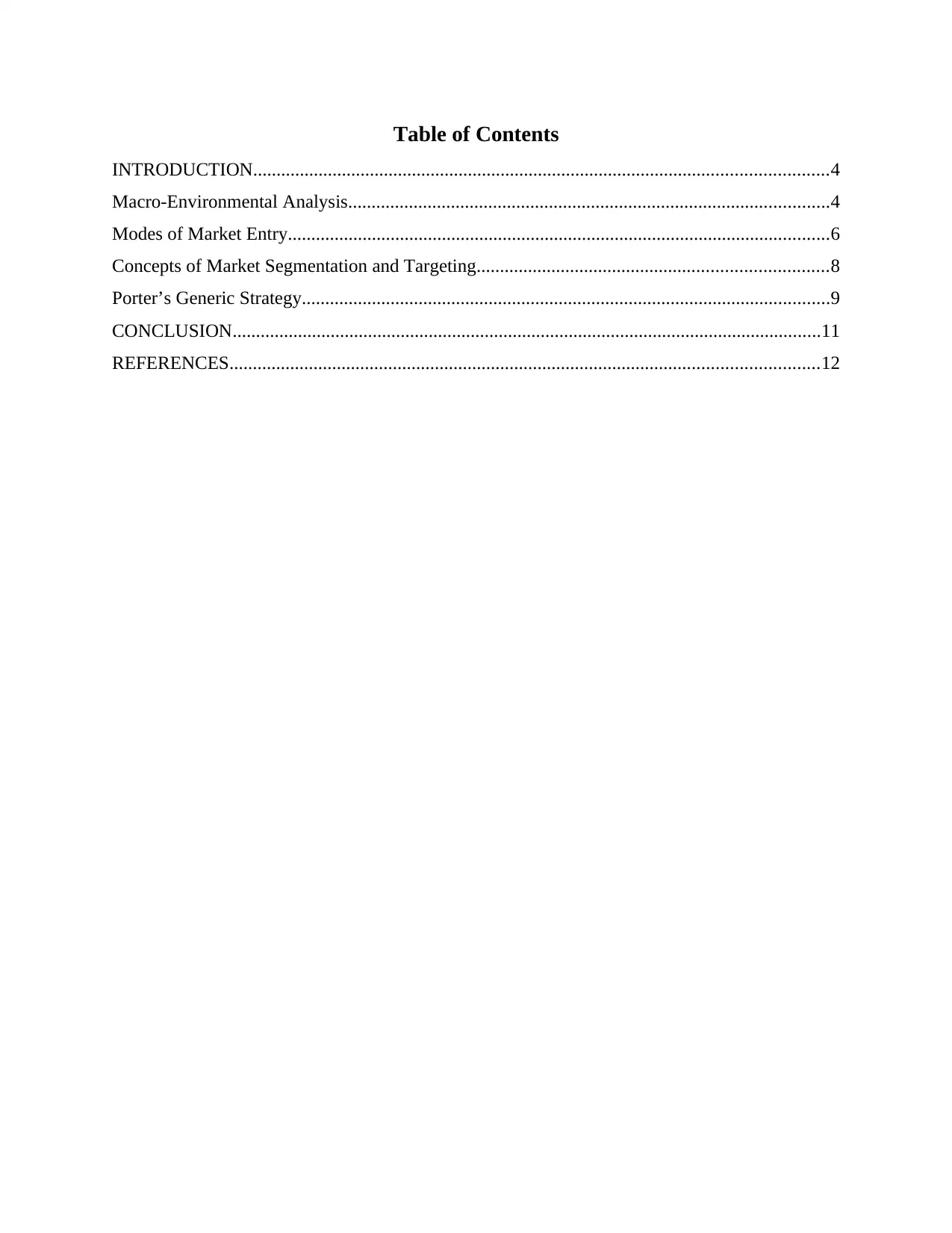
Table of Contents
INTRODUCTION...........................................................................................................................4
Macro-Environmental Analysis.......................................................................................................4
Modes of Market Entry....................................................................................................................6
Concepts of Market Segmentation and Targeting...........................................................................8
Porter’s Generic Strategy.................................................................................................................9
CONCLUSION..............................................................................................................................11
REFERENCES..............................................................................................................................12
INTRODUCTION...........................................................................................................................4
Macro-Environmental Analysis.......................................................................................................4
Modes of Market Entry....................................................................................................................6
Concepts of Market Segmentation and Targeting...........................................................................8
Porter’s Generic Strategy.................................................................................................................9
CONCLUSION..............................................................................................................................11
REFERENCES..............................................................................................................................12
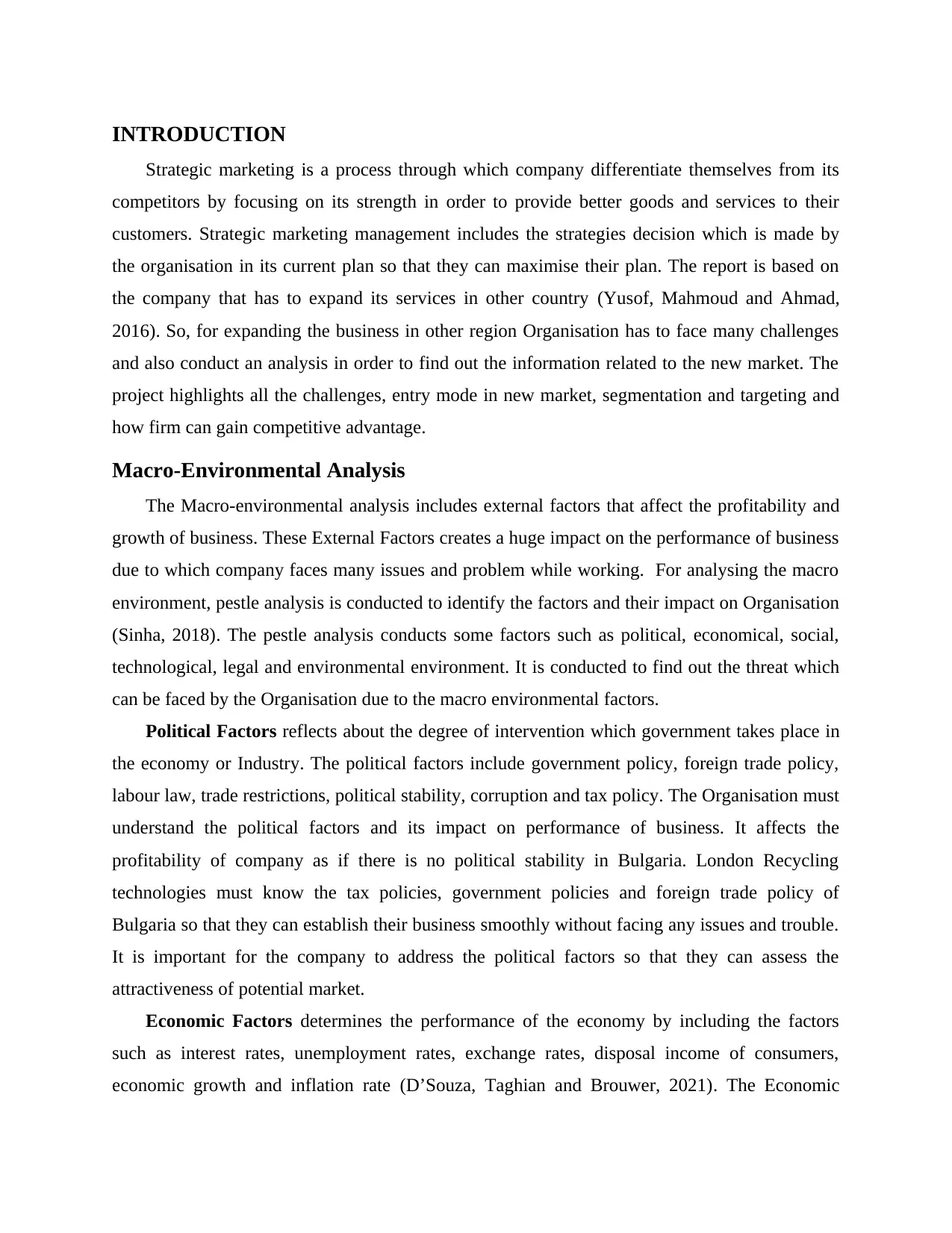
INTRODUCTION
Strategic marketing is a process through which company differentiate themselves from its
competitors by focusing on its strength in order to provide better goods and services to their
customers. Strategic marketing management includes the strategies decision which is made by
the organisation in its current plan so that they can maximise their plan. The report is based on
the company that has to expand its services in other country (Yusof, Mahmoud and Ahmad,
2016). So, for expanding the business in other region Organisation has to face many challenges
and also conduct an analysis in order to find out the information related to the new market. The
project highlights all the challenges, entry mode in new market, segmentation and targeting and
how firm can gain competitive advantage.
Macro-Environmental Analysis
The Macro-environmental analysis includes external factors that affect the profitability and
growth of business. These External Factors creates a huge impact on the performance of business
due to which company faces many issues and problem while working. For analysing the macro
environment, pestle analysis is conducted to identify the factors and their impact on Organisation
(Sinha, 2018). The pestle analysis conducts some factors such as political, economical, social,
technological, legal and environmental environment. It is conducted to find out the threat which
can be faced by the Organisation due to the macro environmental factors.
Political Factors reflects about the degree of intervention which government takes place in
the economy or Industry. The political factors include government policy, foreign trade policy,
labour law, trade restrictions, political stability, corruption and tax policy. The Organisation must
understand the political factors and its impact on performance of business. It affects the
profitability of company as if there is no political stability in Bulgaria. London Recycling
technologies must know the tax policies, government policies and foreign trade policy of
Bulgaria so that they can establish their business smoothly without facing any issues and trouble.
It is important for the company to address the political factors so that they can assess the
attractiveness of potential market.
Economic Factors determines the performance of the economy by including the factors
such as interest rates, unemployment rates, exchange rates, disposal income of consumers,
economic growth and inflation rate (D’Souza, Taghian and Brouwer, 2021). The Economic
Strategic marketing is a process through which company differentiate themselves from its
competitors by focusing on its strength in order to provide better goods and services to their
customers. Strategic marketing management includes the strategies decision which is made by
the organisation in its current plan so that they can maximise their plan. The report is based on
the company that has to expand its services in other country (Yusof, Mahmoud and Ahmad,
2016). So, for expanding the business in other region Organisation has to face many challenges
and also conduct an analysis in order to find out the information related to the new market. The
project highlights all the challenges, entry mode in new market, segmentation and targeting and
how firm can gain competitive advantage.
Macro-Environmental Analysis
The Macro-environmental analysis includes external factors that affect the profitability and
growth of business. These External Factors creates a huge impact on the performance of business
due to which company faces many issues and problem while working. For analysing the macro
environment, pestle analysis is conducted to identify the factors and their impact on Organisation
(Sinha, 2018). The pestle analysis conducts some factors such as political, economical, social,
technological, legal and environmental environment. It is conducted to find out the threat which
can be faced by the Organisation due to the macro environmental factors.
Political Factors reflects about the degree of intervention which government takes place in
the economy or Industry. The political factors include government policy, foreign trade policy,
labour law, trade restrictions, political stability, corruption and tax policy. The Organisation must
understand the political factors and its impact on performance of business. It affects the
profitability of company as if there is no political stability in Bulgaria. London Recycling
technologies must know the tax policies, government policies and foreign trade policy of
Bulgaria so that they can establish their business smoothly without facing any issues and trouble.
It is important for the company to address the political factors so that they can assess the
attractiveness of potential market.
Economic Factors determines the performance of the economy by including the factors
such as interest rates, unemployment rates, exchange rates, disposal income of consumers,
economic growth and inflation rate (D’Souza, Taghian and Brouwer, 2021). The Economic
Secure Best Marks with AI Grader
Need help grading? Try our AI Grader for instant feedback on your assignments.
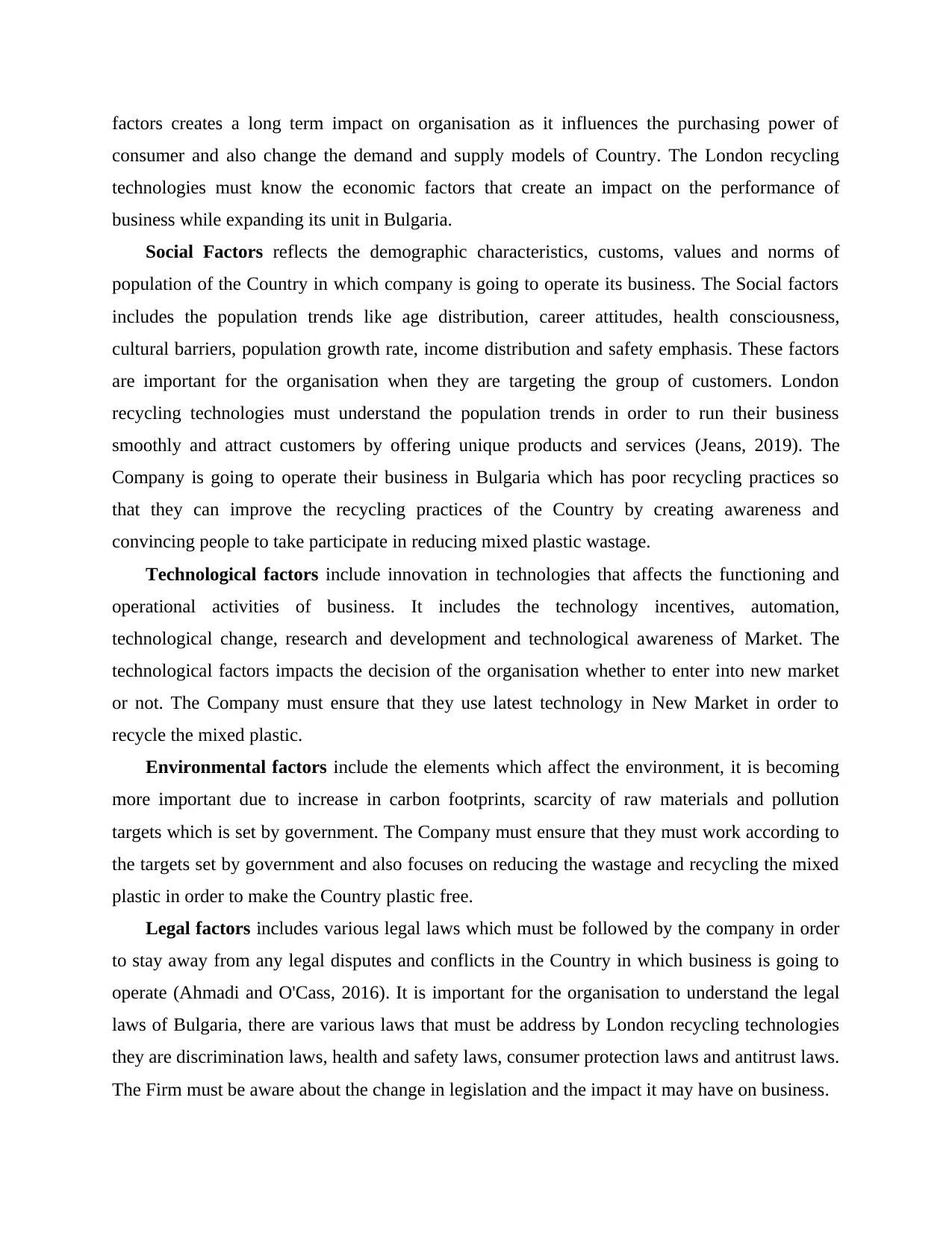
factors creates a long term impact on organisation as it influences the purchasing power of
consumer and also change the demand and supply models of Country. The London recycling
technologies must know the economic factors that create an impact on the performance of
business while expanding its unit in Bulgaria.
Social Factors reflects the demographic characteristics, customs, values and norms of
population of the Country in which company is going to operate its business. The Social factors
includes the population trends like age distribution, career attitudes, health consciousness,
cultural barriers, population growth rate, income distribution and safety emphasis. These factors
are important for the organisation when they are targeting the group of customers. London
recycling technologies must understand the population trends in order to run their business
smoothly and attract customers by offering unique products and services (Jeans, 2019). The
Company is going to operate their business in Bulgaria which has poor recycling practices so
that they can improve the recycling practices of the Country by creating awareness and
convincing people to take participate in reducing mixed plastic wastage.
Technological factors include innovation in technologies that affects the functioning and
operational activities of business. It includes the technology incentives, automation,
technological change, research and development and technological awareness of Market. The
technological factors impacts the decision of the organisation whether to enter into new market
or not. The Company must ensure that they use latest technology in New Market in order to
recycle the mixed plastic.
Environmental factors include the elements which affect the environment, it is becoming
more important due to increase in carbon footprints, scarcity of raw materials and pollution
targets which is set by government. The Company must ensure that they must work according to
the targets set by government and also focuses on reducing the wastage and recycling the mixed
plastic in order to make the Country plastic free.
Legal factors includes various legal laws which must be followed by the company in order
to stay away from any legal disputes and conflicts in the Country in which business is going to
operate (Ahmadi and O'Cass, 2016). It is important for the organisation to understand the legal
laws of Bulgaria, there are various laws that must be address by London recycling technologies
they are discrimination laws, health and safety laws, consumer protection laws and antitrust laws.
The Firm must be aware about the change in legislation and the impact it may have on business.
consumer and also change the demand and supply models of Country. The London recycling
technologies must know the economic factors that create an impact on the performance of
business while expanding its unit in Bulgaria.
Social Factors reflects the demographic characteristics, customs, values and norms of
population of the Country in which company is going to operate its business. The Social factors
includes the population trends like age distribution, career attitudes, health consciousness,
cultural barriers, population growth rate, income distribution and safety emphasis. These factors
are important for the organisation when they are targeting the group of customers. London
recycling technologies must understand the population trends in order to run their business
smoothly and attract customers by offering unique products and services (Jeans, 2019). The
Company is going to operate their business in Bulgaria which has poor recycling practices so
that they can improve the recycling practices of the Country by creating awareness and
convincing people to take participate in reducing mixed plastic wastage.
Technological factors include innovation in technologies that affects the functioning and
operational activities of business. It includes the technology incentives, automation,
technological change, research and development and technological awareness of Market. The
technological factors impacts the decision of the organisation whether to enter into new market
or not. The Company must ensure that they use latest technology in New Market in order to
recycle the mixed plastic.
Environmental factors include the elements which affect the environment, it is becoming
more important due to increase in carbon footprints, scarcity of raw materials and pollution
targets which is set by government. The Company must ensure that they must work according to
the targets set by government and also focuses on reducing the wastage and recycling the mixed
plastic in order to make the Country plastic free.
Legal factors includes various legal laws which must be followed by the company in order
to stay away from any legal disputes and conflicts in the Country in which business is going to
operate (Ahmadi and O'Cass, 2016). It is important for the organisation to understand the legal
laws of Bulgaria, there are various laws that must be address by London recycling technologies
they are discrimination laws, health and safety laws, consumer protection laws and antitrust laws.
The Firm must be aware about the change in legislation and the impact it may have on business.
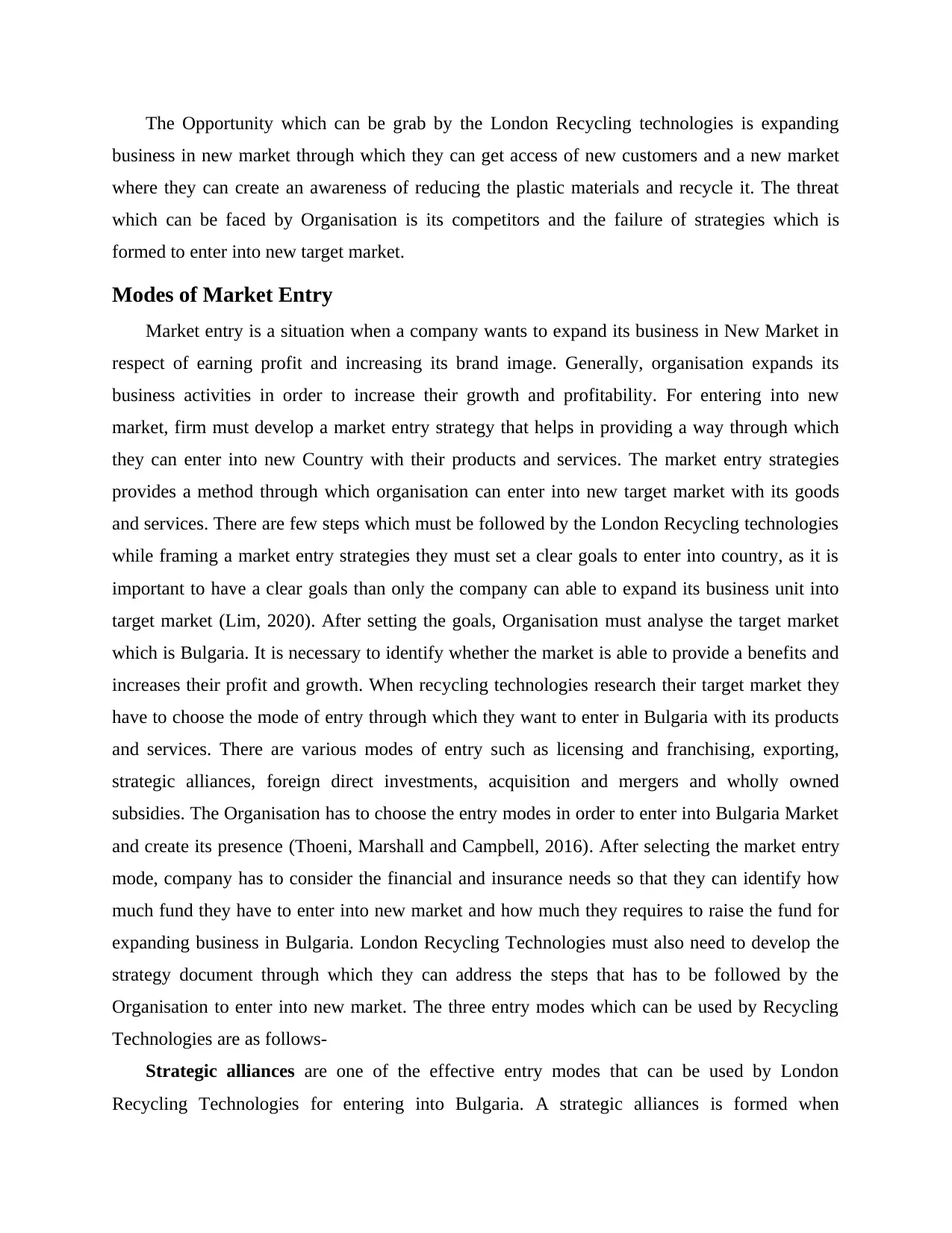
The Opportunity which can be grab by the London Recycling technologies is expanding
business in new market through which they can get access of new customers and a new market
where they can create an awareness of reducing the plastic materials and recycle it. The threat
which can be faced by Organisation is its competitors and the failure of strategies which is
formed to enter into new target market.
Modes of Market Entry
Market entry is a situation when a company wants to expand its business in New Market in
respect of earning profit and increasing its brand image. Generally, organisation expands its
business activities in order to increase their growth and profitability. For entering into new
market, firm must develop a market entry strategy that helps in providing a way through which
they can enter into new Country with their products and services. The market entry strategies
provides a method through which organisation can enter into new target market with its goods
and services. There are few steps which must be followed by the London Recycling technologies
while framing a market entry strategies they must set a clear goals to enter into country, as it is
important to have a clear goals than only the company can able to expand its business unit into
target market (Lim, 2020). After setting the goals, Organisation must analyse the target market
which is Bulgaria. It is necessary to identify whether the market is able to provide a benefits and
increases their profit and growth. When recycling technologies research their target market they
have to choose the mode of entry through which they want to enter in Bulgaria with its products
and services. There are various modes of entry such as licensing and franchising, exporting,
strategic alliances, foreign direct investments, acquisition and mergers and wholly owned
subsidies. The Organisation has to choose the entry modes in order to enter into Bulgaria Market
and create its presence (Thoeni, Marshall and Campbell, 2016). After selecting the market entry
mode, company has to consider the financial and insurance needs so that they can identify how
much fund they have to enter into new market and how much they requires to raise the fund for
expanding business in Bulgaria. London Recycling Technologies must also need to develop the
strategy document through which they can address the steps that has to be followed by the
Organisation to enter into new market. The three entry modes which can be used by Recycling
Technologies are as follows-
Strategic alliances are one of the effective entry modes that can be used by London
Recycling Technologies for entering into Bulgaria. A strategic alliances is formed when
business in new market through which they can get access of new customers and a new market
where they can create an awareness of reducing the plastic materials and recycle it. The threat
which can be faced by Organisation is its competitors and the failure of strategies which is
formed to enter into new target market.
Modes of Market Entry
Market entry is a situation when a company wants to expand its business in New Market in
respect of earning profit and increasing its brand image. Generally, organisation expands its
business activities in order to increase their growth and profitability. For entering into new
market, firm must develop a market entry strategy that helps in providing a way through which
they can enter into new Country with their products and services. The market entry strategies
provides a method through which organisation can enter into new target market with its goods
and services. There are few steps which must be followed by the London Recycling technologies
while framing a market entry strategies they must set a clear goals to enter into country, as it is
important to have a clear goals than only the company can able to expand its business unit into
target market (Lim, 2020). After setting the goals, Organisation must analyse the target market
which is Bulgaria. It is necessary to identify whether the market is able to provide a benefits and
increases their profit and growth. When recycling technologies research their target market they
have to choose the mode of entry through which they want to enter in Bulgaria with its products
and services. There are various modes of entry such as licensing and franchising, exporting,
strategic alliances, foreign direct investments, acquisition and mergers and wholly owned
subsidies. The Organisation has to choose the entry modes in order to enter into Bulgaria Market
and create its presence (Thoeni, Marshall and Campbell, 2016). After selecting the market entry
mode, company has to consider the financial and insurance needs so that they can identify how
much fund they have to enter into new market and how much they requires to raise the fund for
expanding business in Bulgaria. London Recycling Technologies must also need to develop the
strategy document through which they can address the steps that has to be followed by the
Organisation to enter into new market. The three entry modes which can be used by Recycling
Technologies are as follows-
Strategic alliances are one of the effective entry modes that can be used by London
Recycling Technologies for entering into Bulgaria. A strategic alliances is formed when
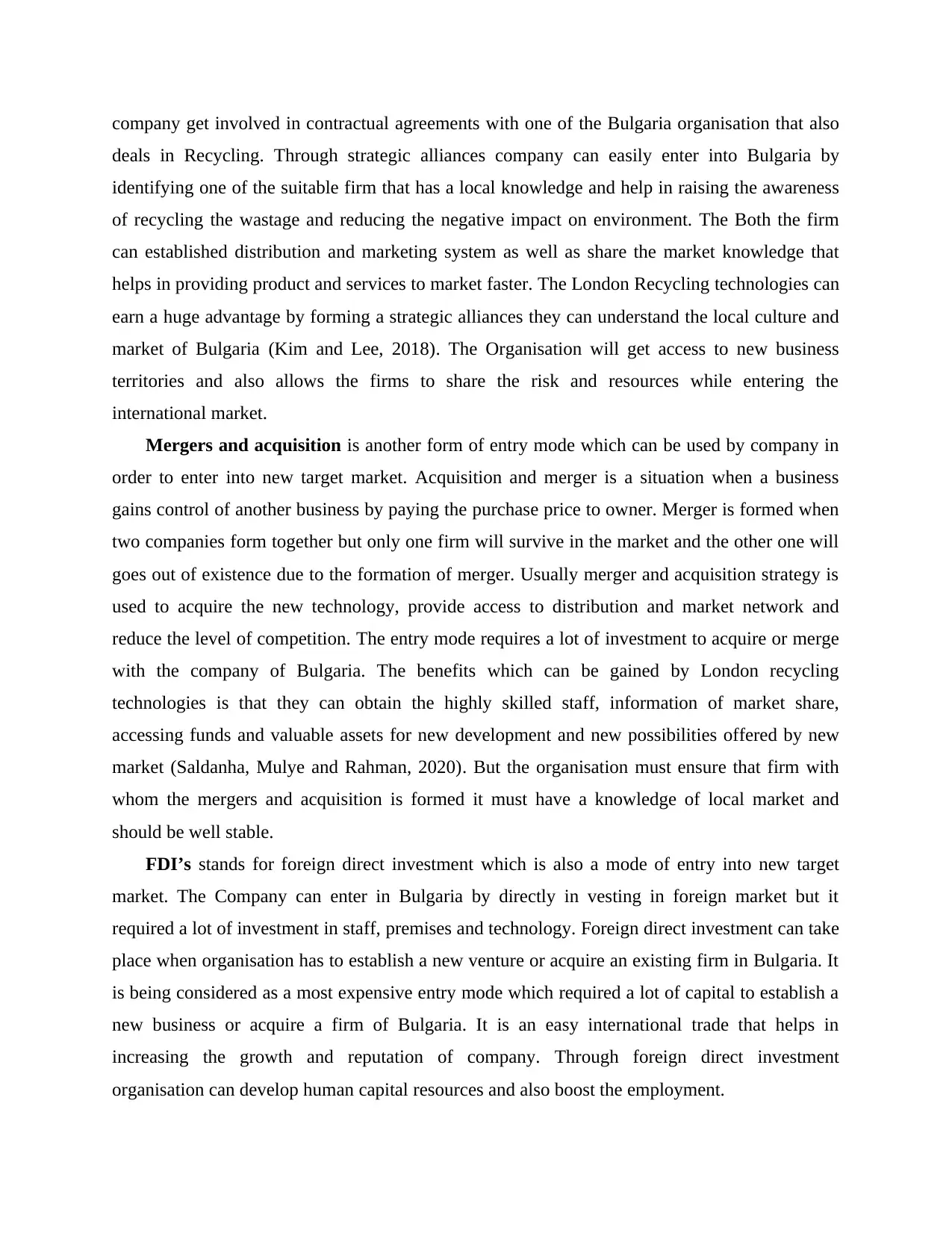
company get involved in contractual agreements with one of the Bulgaria organisation that also
deals in Recycling. Through strategic alliances company can easily enter into Bulgaria by
identifying one of the suitable firm that has a local knowledge and help in raising the awareness
of recycling the wastage and reducing the negative impact on environment. The Both the firm
can established distribution and marketing system as well as share the market knowledge that
helps in providing product and services to market faster. The London Recycling technologies can
earn a huge advantage by forming a strategic alliances they can understand the local culture and
market of Bulgaria (Kim and Lee, 2018). The Organisation will get access to new business
territories and also allows the firms to share the risk and resources while entering the
international market.
Mergers and acquisition is another form of entry mode which can be used by company in
order to enter into new target market. Acquisition and merger is a situation when a business
gains control of another business by paying the purchase price to owner. Merger is formed when
two companies form together but only one firm will survive in the market and the other one will
goes out of existence due to the formation of merger. Usually merger and acquisition strategy is
used to acquire the new technology, provide access to distribution and market network and
reduce the level of competition. The entry mode requires a lot of investment to acquire or merge
with the company of Bulgaria. The benefits which can be gained by London recycling
technologies is that they can obtain the highly skilled staff, information of market share,
accessing funds and valuable assets for new development and new possibilities offered by new
market (Saldanha, Mulye and Rahman, 2020). But the organisation must ensure that firm with
whom the mergers and acquisition is formed it must have a knowledge of local market and
should be well stable.
FDI’s stands for foreign direct investment which is also a mode of entry into new target
market. The Company can enter in Bulgaria by directly in vesting in foreign market but it
required a lot of investment in staff, premises and technology. Foreign direct investment can take
place when organisation has to establish a new venture or acquire an existing firm in Bulgaria. It
is being considered as a most expensive entry mode which required a lot of capital to establish a
new business or acquire a firm of Bulgaria. It is an easy international trade that helps in
increasing the growth and reputation of company. Through foreign direct investment
organisation can develop human capital resources and also boost the employment.
deals in Recycling. Through strategic alliances company can easily enter into Bulgaria by
identifying one of the suitable firm that has a local knowledge and help in raising the awareness
of recycling the wastage and reducing the negative impact on environment. The Both the firm
can established distribution and marketing system as well as share the market knowledge that
helps in providing product and services to market faster. The London Recycling technologies can
earn a huge advantage by forming a strategic alliances they can understand the local culture and
market of Bulgaria (Kim and Lee, 2018). The Organisation will get access to new business
territories and also allows the firms to share the risk and resources while entering the
international market.
Mergers and acquisition is another form of entry mode which can be used by company in
order to enter into new target market. Acquisition and merger is a situation when a business
gains control of another business by paying the purchase price to owner. Merger is formed when
two companies form together but only one firm will survive in the market and the other one will
goes out of existence due to the formation of merger. Usually merger and acquisition strategy is
used to acquire the new technology, provide access to distribution and market network and
reduce the level of competition. The entry mode requires a lot of investment to acquire or merge
with the company of Bulgaria. The benefits which can be gained by London recycling
technologies is that they can obtain the highly skilled staff, information of market share,
accessing funds and valuable assets for new development and new possibilities offered by new
market (Saldanha, Mulye and Rahman, 2020). But the organisation must ensure that firm with
whom the mergers and acquisition is formed it must have a knowledge of local market and
should be well stable.
FDI’s stands for foreign direct investment which is also a mode of entry into new target
market. The Company can enter in Bulgaria by directly in vesting in foreign market but it
required a lot of investment in staff, premises and technology. Foreign direct investment can take
place when organisation has to establish a new venture or acquire an existing firm in Bulgaria. It
is being considered as a most expensive entry mode which required a lot of capital to establish a
new business or acquire a firm of Bulgaria. It is an easy international trade that helps in
increasing the growth and reputation of company. Through foreign direct investment
organisation can develop human capital resources and also boost the employment.
Paraphrase This Document
Need a fresh take? Get an instant paraphrase of this document with our AI Paraphraser
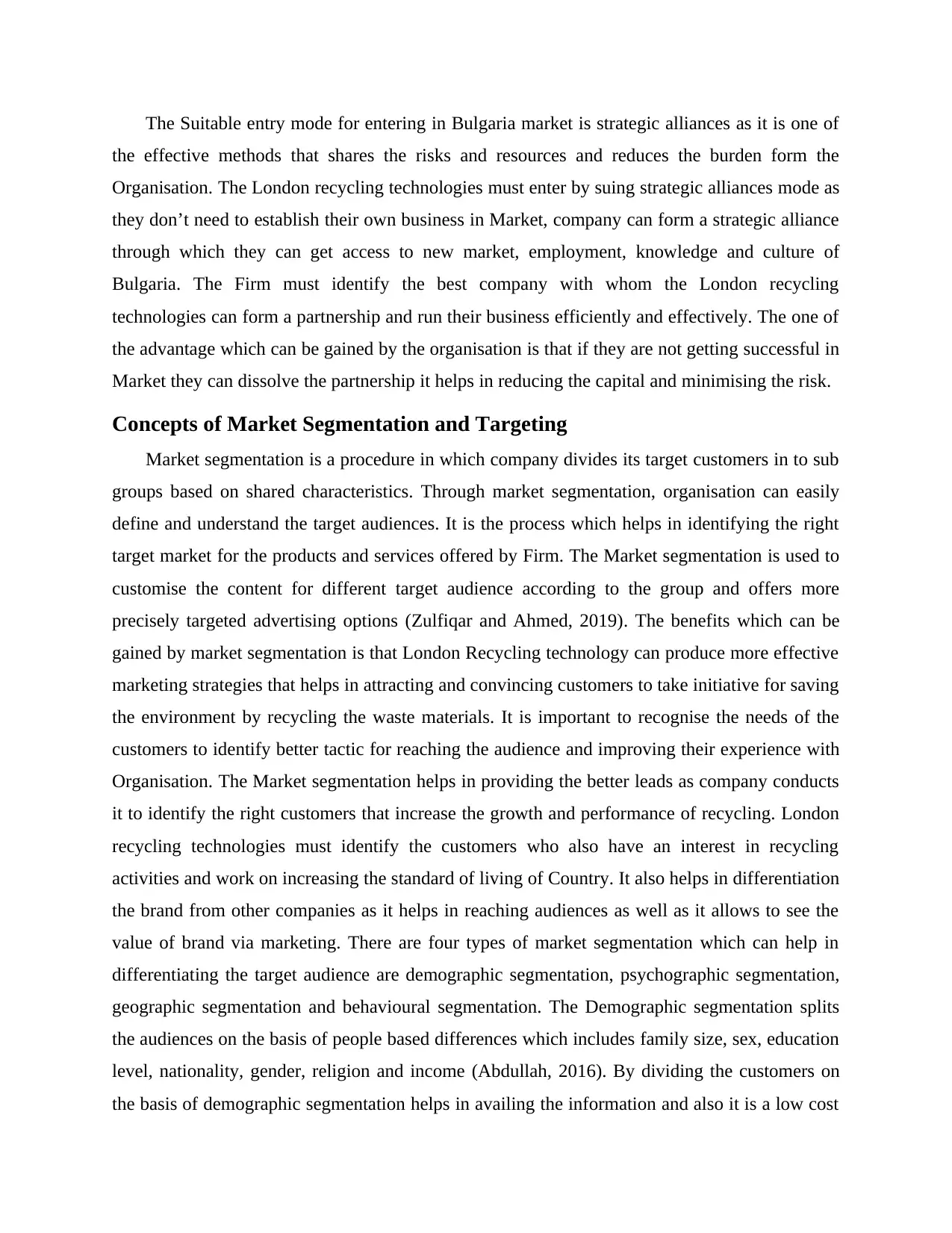
The Suitable entry mode for entering in Bulgaria market is strategic alliances as it is one of
the effective methods that shares the risks and resources and reduces the burden form the
Organisation. The London recycling technologies must enter by suing strategic alliances mode as
they don’t need to establish their own business in Market, company can form a strategic alliance
through which they can get access to new market, employment, knowledge and culture of
Bulgaria. The Firm must identify the best company with whom the London recycling
technologies can form a partnership and run their business efficiently and effectively. The one of
the advantage which can be gained by the organisation is that if they are not getting successful in
Market they can dissolve the partnership it helps in reducing the capital and minimising the risk.
Concepts of Market Segmentation and Targeting
Market segmentation is a procedure in which company divides its target customers in to sub
groups based on shared characteristics. Through market segmentation, organisation can easily
define and understand the target audiences. It is the process which helps in identifying the right
target market for the products and services offered by Firm. The Market segmentation is used to
customise the content for different target audience according to the group and offers more
precisely targeted advertising options (Zulfiqar and Ahmed, 2019). The benefits which can be
gained by market segmentation is that London Recycling technology can produce more effective
marketing strategies that helps in attracting and convincing customers to take initiative for saving
the environment by recycling the waste materials. It is important to recognise the needs of the
customers to identify better tactic for reaching the audience and improving their experience with
Organisation. The Market segmentation helps in providing the better leads as company conducts
it to identify the right customers that increase the growth and performance of recycling. London
recycling technologies must identify the customers who also have an interest in recycling
activities and work on increasing the standard of living of Country. It also helps in differentiation
the brand from other companies as it helps in reaching audiences as well as it allows to see the
value of brand via marketing. There are four types of market segmentation which can help in
differentiating the target audience are demographic segmentation, psychographic segmentation,
geographic segmentation and behavioural segmentation. The Demographic segmentation splits
the audiences on the basis of people based differences which includes family size, sex, education
level, nationality, gender, religion and income (Abdullah, 2016). By dividing the customers on
the basis of demographic segmentation helps in availing the information and also it is a low cost
the effective methods that shares the risks and resources and reduces the burden form the
Organisation. The London recycling technologies must enter by suing strategic alliances mode as
they don’t need to establish their own business in Market, company can form a strategic alliance
through which they can get access to new market, employment, knowledge and culture of
Bulgaria. The Firm must identify the best company with whom the London recycling
technologies can form a partnership and run their business efficiently and effectively. The one of
the advantage which can be gained by the organisation is that if they are not getting successful in
Market they can dissolve the partnership it helps in reducing the capital and minimising the risk.
Concepts of Market Segmentation and Targeting
Market segmentation is a procedure in which company divides its target customers in to sub
groups based on shared characteristics. Through market segmentation, organisation can easily
define and understand the target audiences. It is the process which helps in identifying the right
target market for the products and services offered by Firm. The Market segmentation is used to
customise the content for different target audience according to the group and offers more
precisely targeted advertising options (Zulfiqar and Ahmed, 2019). The benefits which can be
gained by market segmentation is that London Recycling technology can produce more effective
marketing strategies that helps in attracting and convincing customers to take initiative for saving
the environment by recycling the waste materials. It is important to recognise the needs of the
customers to identify better tactic for reaching the audience and improving their experience with
Organisation. The Market segmentation helps in providing the better leads as company conducts
it to identify the right customers that increase the growth and performance of recycling. London
recycling technologies must identify the customers who also have an interest in recycling
activities and work on increasing the standard of living of Country. It also helps in differentiation
the brand from other companies as it helps in reaching audiences as well as it allows to see the
value of brand via marketing. There are four types of market segmentation which can help in
differentiating the target audience are demographic segmentation, psychographic segmentation,
geographic segmentation and behavioural segmentation. The Demographic segmentation splits
the audiences on the basis of people based differences which includes family size, sex, education
level, nationality, gender, religion and income (Abdullah, 2016). By dividing the customers on
the basis of demographic segmentation helps in availing the information and also it is a low cost
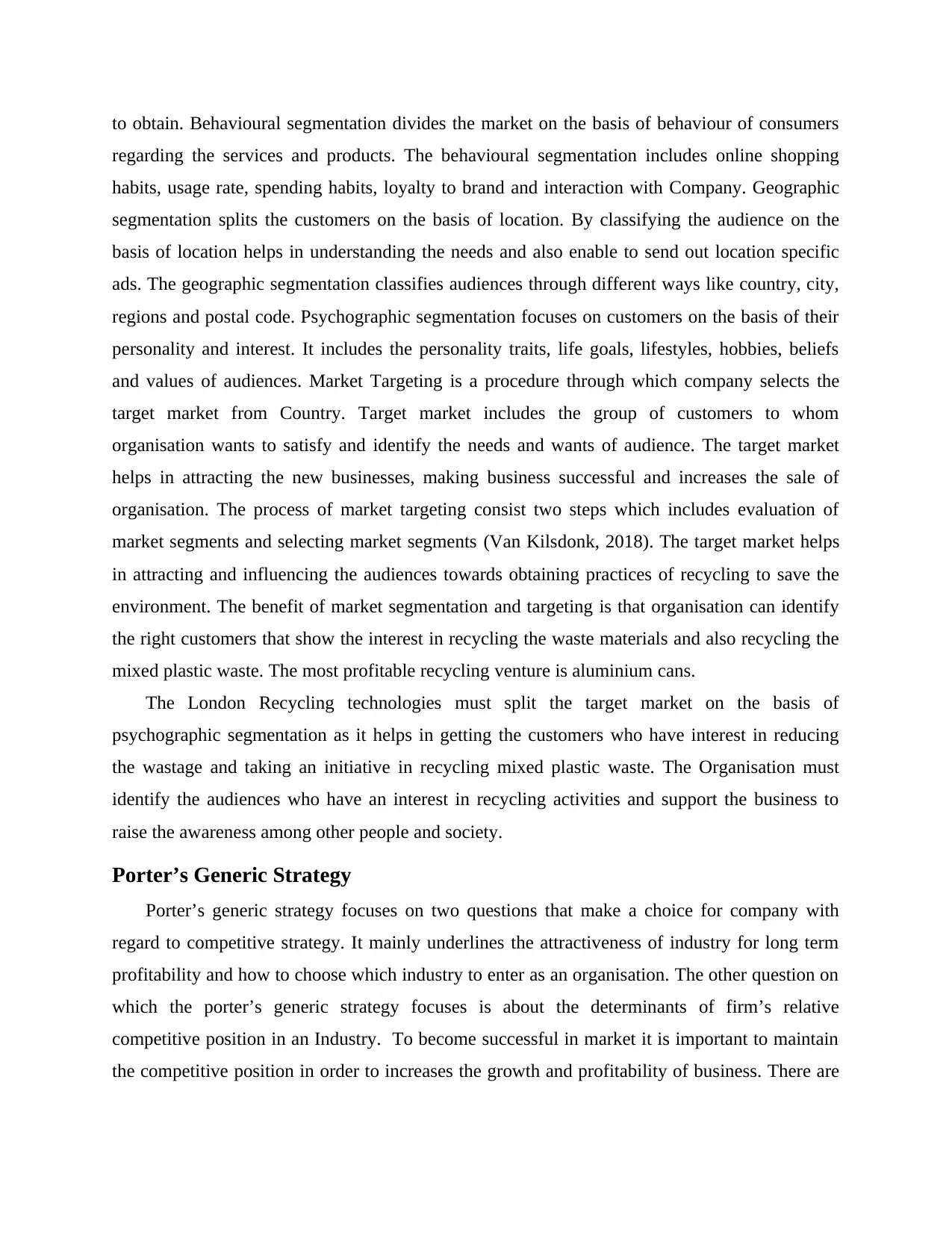
to obtain. Behavioural segmentation divides the market on the basis of behaviour of consumers
regarding the services and products. The behavioural segmentation includes online shopping
habits, usage rate, spending habits, loyalty to brand and interaction with Company. Geographic
segmentation splits the customers on the basis of location. By classifying the audience on the
basis of location helps in understanding the needs and also enable to send out location specific
ads. The geographic segmentation classifies audiences through different ways like country, city,
regions and postal code. Psychographic segmentation focuses on customers on the basis of their
personality and interest. It includes the personality traits, life goals, lifestyles, hobbies, beliefs
and values of audiences. Market Targeting is a procedure through which company selects the
target market from Country. Target market includes the group of customers to whom
organisation wants to satisfy and identify the needs and wants of audience. The target market
helps in attracting the new businesses, making business successful and increases the sale of
organisation. The process of market targeting consist two steps which includes evaluation of
market segments and selecting market segments (Van Kilsdonk, 2018). The target market helps
in attracting and influencing the audiences towards obtaining practices of recycling to save the
environment. The benefit of market segmentation and targeting is that organisation can identify
the right customers that show the interest in recycling the waste materials and also recycling the
mixed plastic waste. The most profitable recycling venture is aluminium cans.
The London Recycling technologies must split the target market on the basis of
psychographic segmentation as it helps in getting the customers who have interest in reducing
the wastage and taking an initiative in recycling mixed plastic waste. The Organisation must
identify the audiences who have an interest in recycling activities and support the business to
raise the awareness among other people and society.
Porter’s Generic Strategy
Porter’s generic strategy focuses on two questions that make a choice for company with
regard to competitive strategy. It mainly underlines the attractiveness of industry for long term
profitability and how to choose which industry to enter as an organisation. The other question on
which the porter’s generic strategy focuses is about the determinants of firm’s relative
competitive position in an Industry. To become successful in market it is important to maintain
the competitive position in order to increases the growth and profitability of business. There are
regarding the services and products. The behavioural segmentation includes online shopping
habits, usage rate, spending habits, loyalty to brand and interaction with Company. Geographic
segmentation splits the customers on the basis of location. By classifying the audience on the
basis of location helps in understanding the needs and also enable to send out location specific
ads. The geographic segmentation classifies audiences through different ways like country, city,
regions and postal code. Psychographic segmentation focuses on customers on the basis of their
personality and interest. It includes the personality traits, life goals, lifestyles, hobbies, beliefs
and values of audiences. Market Targeting is a procedure through which company selects the
target market from Country. Target market includes the group of customers to whom
organisation wants to satisfy and identify the needs and wants of audience. The target market
helps in attracting the new businesses, making business successful and increases the sale of
organisation. The process of market targeting consist two steps which includes evaluation of
market segments and selecting market segments (Van Kilsdonk, 2018). The target market helps
in attracting and influencing the audiences towards obtaining practices of recycling to save the
environment. The benefit of market segmentation and targeting is that organisation can identify
the right customers that show the interest in recycling the waste materials and also recycling the
mixed plastic waste. The most profitable recycling venture is aluminium cans.
The London Recycling technologies must split the target market on the basis of
psychographic segmentation as it helps in getting the customers who have interest in reducing
the wastage and taking an initiative in recycling mixed plastic waste. The Organisation must
identify the audiences who have an interest in recycling activities and support the business to
raise the awareness among other people and society.
Porter’s Generic Strategy
Porter’s generic strategy focuses on two questions that make a choice for company with
regard to competitive strategy. It mainly underlines the attractiveness of industry for long term
profitability and how to choose which industry to enter as an organisation. The other question on
which the porter’s generic strategy focuses is about the determinants of firm’s relative
competitive position in an Industry. To become successful in market it is important to maintain
the competitive position in order to increases the growth and profitability of business. There are
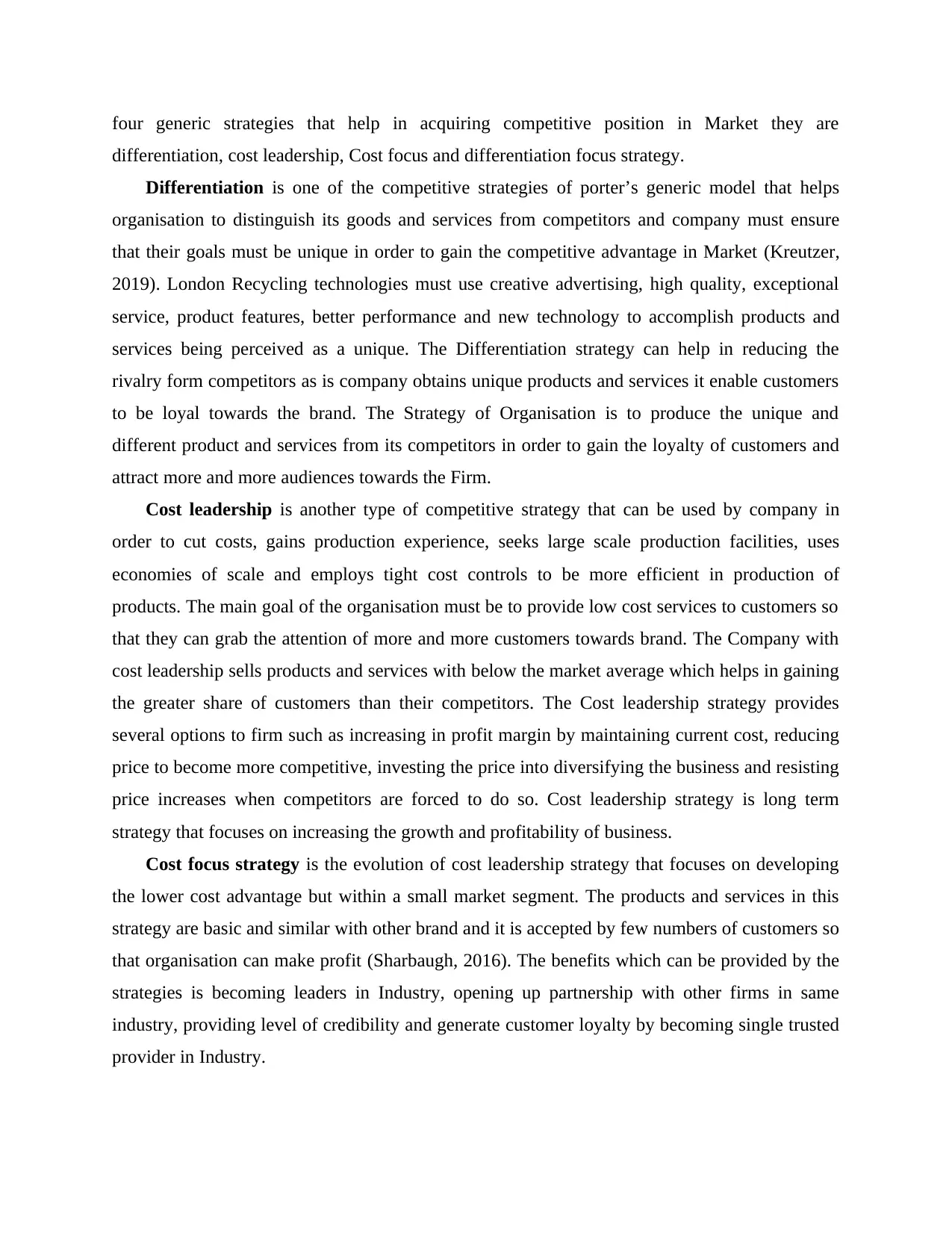
four generic strategies that help in acquiring competitive position in Market they are
differentiation, cost leadership, Cost focus and differentiation focus strategy.
Differentiation is one of the competitive strategies of porter’s generic model that helps
organisation to distinguish its goods and services from competitors and company must ensure
that their goals must be unique in order to gain the competitive advantage in Market (Kreutzer,
2019). London Recycling technologies must use creative advertising, high quality, exceptional
service, product features, better performance and new technology to accomplish products and
services being perceived as a unique. The Differentiation strategy can help in reducing the
rivalry form competitors as is company obtains unique products and services it enable customers
to be loyal towards the brand. The Strategy of Organisation is to produce the unique and
different product and services from its competitors in order to gain the loyalty of customers and
attract more and more audiences towards the Firm.
Cost leadership is another type of competitive strategy that can be used by company in
order to cut costs, gains production experience, seeks large scale production facilities, uses
economies of scale and employs tight cost controls to be more efficient in production of
products. The main goal of the organisation must be to provide low cost services to customers so
that they can grab the attention of more and more customers towards brand. The Company with
cost leadership sells products and services with below the market average which helps in gaining
the greater share of customers than their competitors. The Cost leadership strategy provides
several options to firm such as increasing in profit margin by maintaining current cost, reducing
price to become more competitive, investing the price into diversifying the business and resisting
price increases when competitors are forced to do so. Cost leadership strategy is long term
strategy that focuses on increasing the growth and profitability of business.
Cost focus strategy is the evolution of cost leadership strategy that focuses on developing
the lower cost advantage but within a small market segment. The products and services in this
strategy are basic and similar with other brand and it is accepted by few numbers of customers so
that organisation can make profit (Sharbaugh, 2016). The benefits which can be provided by the
strategies is becoming leaders in Industry, opening up partnership with other firms in same
industry, providing level of credibility and generate customer loyalty by becoming single trusted
provider in Industry.
differentiation, cost leadership, Cost focus and differentiation focus strategy.
Differentiation is one of the competitive strategies of porter’s generic model that helps
organisation to distinguish its goods and services from competitors and company must ensure
that their goals must be unique in order to gain the competitive advantage in Market (Kreutzer,
2019). London Recycling technologies must use creative advertising, high quality, exceptional
service, product features, better performance and new technology to accomplish products and
services being perceived as a unique. The Differentiation strategy can help in reducing the
rivalry form competitors as is company obtains unique products and services it enable customers
to be loyal towards the brand. The Strategy of Organisation is to produce the unique and
different product and services from its competitors in order to gain the loyalty of customers and
attract more and more audiences towards the Firm.
Cost leadership is another type of competitive strategy that can be used by company in
order to cut costs, gains production experience, seeks large scale production facilities, uses
economies of scale and employs tight cost controls to be more efficient in production of
products. The main goal of the organisation must be to provide low cost services to customers so
that they can grab the attention of more and more customers towards brand. The Company with
cost leadership sells products and services with below the market average which helps in gaining
the greater share of customers than their competitors. The Cost leadership strategy provides
several options to firm such as increasing in profit margin by maintaining current cost, reducing
price to become more competitive, investing the price into diversifying the business and resisting
price increases when competitors are forced to do so. Cost leadership strategy is long term
strategy that focuses on increasing the growth and profitability of business.
Cost focus strategy is the evolution of cost leadership strategy that focuses on developing
the lower cost advantage but within a small market segment. The products and services in this
strategy are basic and similar with other brand and it is accepted by few numbers of customers so
that organisation can make profit (Sharbaugh, 2016). The benefits which can be provided by the
strategies is becoming leaders in Industry, opening up partnership with other firms in same
industry, providing level of credibility and generate customer loyalty by becoming single trusted
provider in Industry.
Secure Best Marks with AI Grader
Need help grading? Try our AI Grader for instant feedback on your assignments.
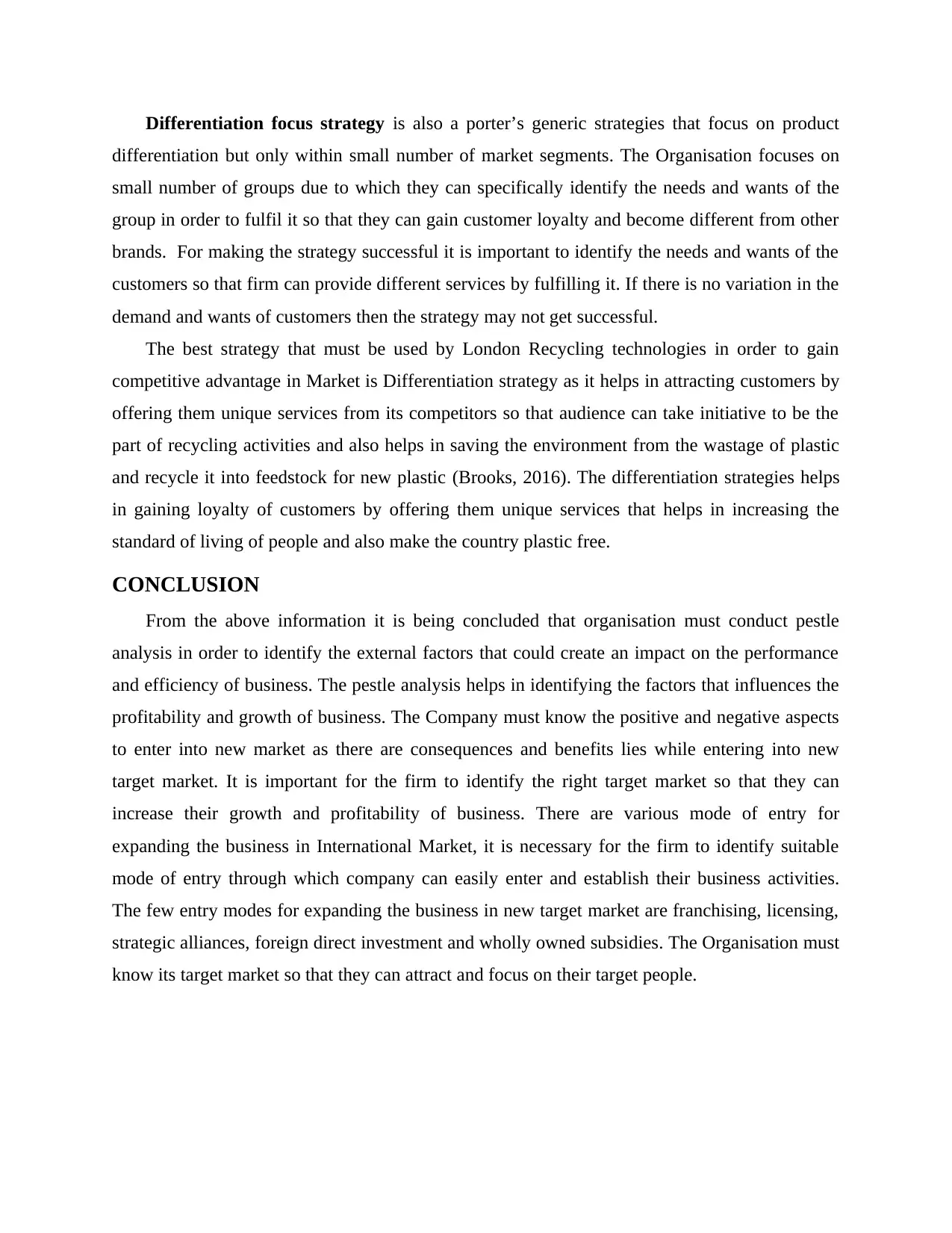
Differentiation focus strategy is also a porter’s generic strategies that focus on product
differentiation but only within small number of market segments. The Organisation focuses on
small number of groups due to which they can specifically identify the needs and wants of the
group in order to fulfil it so that they can gain customer loyalty and become different from other
brands. For making the strategy successful it is important to identify the needs and wants of the
customers so that firm can provide different services by fulfilling it. If there is no variation in the
demand and wants of customers then the strategy may not get successful.
The best strategy that must be used by London Recycling technologies in order to gain
competitive advantage in Market is Differentiation strategy as it helps in attracting customers by
offering them unique services from its competitors so that audience can take initiative to be the
part of recycling activities and also helps in saving the environment from the wastage of plastic
and recycle it into feedstock for new plastic (Brooks, 2016). The differentiation strategies helps
in gaining loyalty of customers by offering them unique services that helps in increasing the
standard of living of people and also make the country plastic free.
CONCLUSION
From the above information it is being concluded that organisation must conduct pestle
analysis in order to identify the external factors that could create an impact on the performance
and efficiency of business. The pestle analysis helps in identifying the factors that influences the
profitability and growth of business. The Company must know the positive and negative aspects
to enter into new market as there are consequences and benefits lies while entering into new
target market. It is important for the firm to identify the right target market so that they can
increase their growth and profitability of business. There are various mode of entry for
expanding the business in International Market, it is necessary for the firm to identify suitable
mode of entry through which company can easily enter and establish their business activities.
The few entry modes for expanding the business in new target market are franchising, licensing,
strategic alliances, foreign direct investment and wholly owned subsidies. The Organisation must
know its target market so that they can attract and focus on their target people.
differentiation but only within small number of market segments. The Organisation focuses on
small number of groups due to which they can specifically identify the needs and wants of the
group in order to fulfil it so that they can gain customer loyalty and become different from other
brands. For making the strategy successful it is important to identify the needs and wants of the
customers so that firm can provide different services by fulfilling it. If there is no variation in the
demand and wants of customers then the strategy may not get successful.
The best strategy that must be used by London Recycling technologies in order to gain
competitive advantage in Market is Differentiation strategy as it helps in attracting customers by
offering them unique services from its competitors so that audience can take initiative to be the
part of recycling activities and also helps in saving the environment from the wastage of plastic
and recycle it into feedstock for new plastic (Brooks, 2016). The differentiation strategies helps
in gaining loyalty of customers by offering them unique services that helps in increasing the
standard of living of people and also make the country plastic free.
CONCLUSION
From the above information it is being concluded that organisation must conduct pestle
analysis in order to identify the external factors that could create an impact on the performance
and efficiency of business. The pestle analysis helps in identifying the factors that influences the
profitability and growth of business. The Company must know the positive and negative aspects
to enter into new market as there are consequences and benefits lies while entering into new
target market. It is important for the firm to identify the right target market so that they can
increase their growth and profitability of business. There are various mode of entry for
expanding the business in International Market, it is necessary for the firm to identify suitable
mode of entry through which company can easily enter and establish their business activities.
The few entry modes for expanding the business in new target market are franchising, licensing,
strategic alliances, foreign direct investment and wholly owned subsidies. The Organisation must
know its target market so that they can attract and focus on their target people.
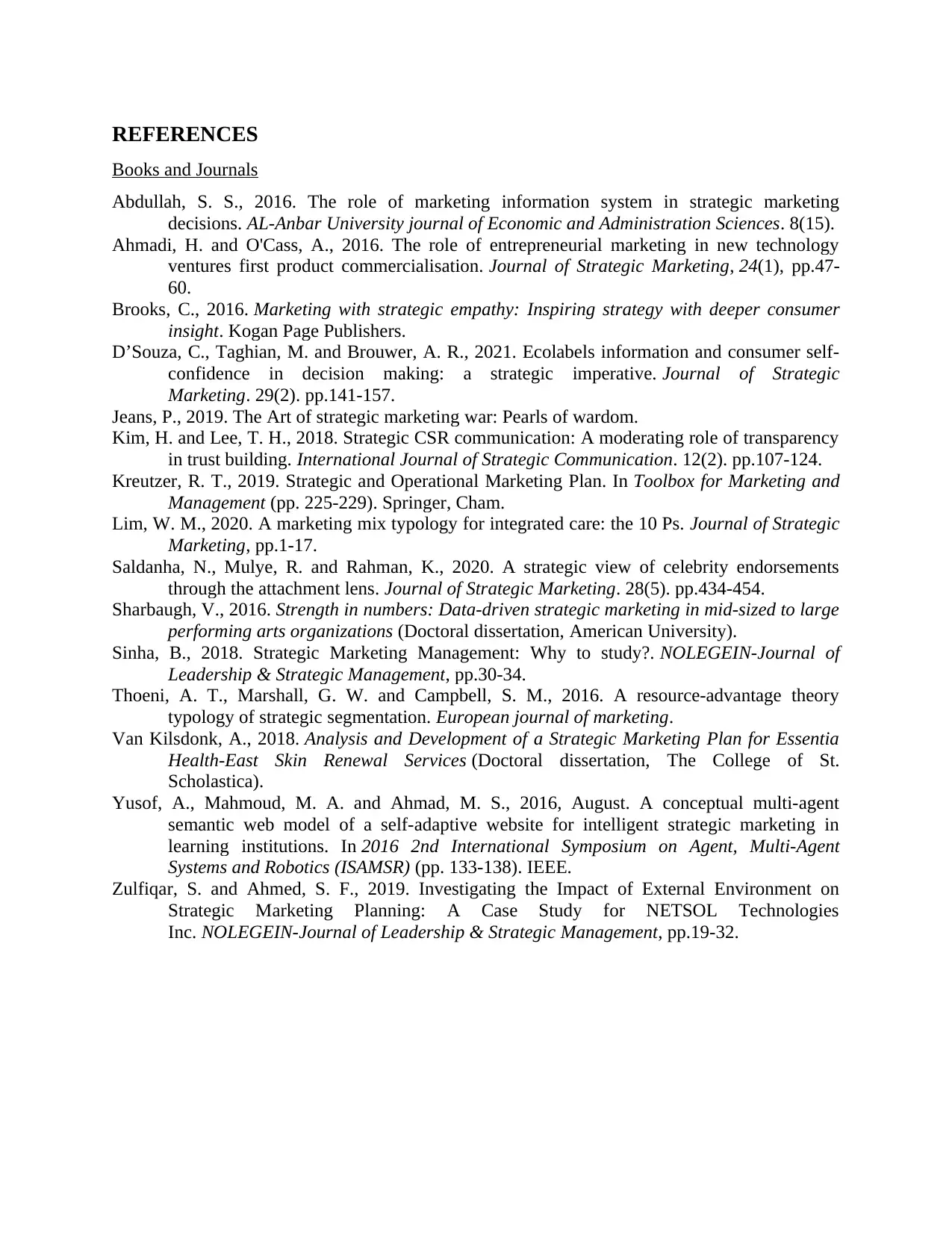
REFERENCES
Books and Journals
Abdullah, S. S., 2016. The role of marketing information system in strategic marketing
decisions. AL-Anbar University journal of Economic and Administration Sciences. 8(15).
Ahmadi, H. and O'Cass, A., 2016. The role of entrepreneurial marketing in new technology
ventures first product commercialisation. Journal of Strategic Marketing, 24(1), pp.47-
60.
Brooks, C., 2016. Marketing with strategic empathy: Inspiring strategy with deeper consumer
insight. Kogan Page Publishers.
D’Souza, C., Taghian, M. and Brouwer, A. R., 2021. Ecolabels information and consumer self-
confidence in decision making: a strategic imperative. Journal of Strategic
Marketing. 29(2). pp.141-157.
Jeans, P., 2019. The Art of strategic marketing war: Pearls of wardom.
Kim, H. and Lee, T. H., 2018. Strategic CSR communication: A moderating role of transparency
in trust building. International Journal of Strategic Communication. 12(2). pp.107-124.
Kreutzer, R. T., 2019. Strategic and Operational Marketing Plan. In Toolbox for Marketing and
Management (pp. 225-229). Springer, Cham.
Lim, W. M., 2020. A marketing mix typology for integrated care: the 10 Ps. Journal of Strategic
Marketing, pp.1-17.
Saldanha, N., Mulye, R. and Rahman, K., 2020. A strategic view of celebrity endorsements
through the attachment lens. Journal of Strategic Marketing. 28(5). pp.434-454.
Sharbaugh, V., 2016. Strength in numbers: Data-driven strategic marketing in mid-sized to large
performing arts organizations (Doctoral dissertation, American University).
Sinha, B., 2018. Strategic Marketing Management: Why to study?. NOLEGEIN-Journal of
Leadership & Strategic Management, pp.30-34.
Thoeni, A. T., Marshall, G. W. and Campbell, S. M., 2016. A resource-advantage theory
typology of strategic segmentation. European journal of marketing.
Van Kilsdonk, A., 2018. Analysis and Development of a Strategic Marketing Plan for Essentia
Health-East Skin Renewal Services (Doctoral dissertation, The College of St.
Scholastica).
Yusof, A., Mahmoud, M. A. and Ahmad, M. S., 2016, August. A conceptual multi-agent
semantic web model of a self-adaptive website for intelligent strategic marketing in
learning institutions. In 2016 2nd International Symposium on Agent, Multi-Agent
Systems and Robotics (ISAMSR) (pp. 133-138). IEEE.
Zulfiqar, S. and Ahmed, S. F., 2019. Investigating the Impact of External Environment on
Strategic Marketing Planning: A Case Study for NETSOL Technologies
Inc. NOLEGEIN-Journal of Leadership & Strategic Management, pp.19-32.
Books and Journals
Abdullah, S. S., 2016. The role of marketing information system in strategic marketing
decisions. AL-Anbar University journal of Economic and Administration Sciences. 8(15).
Ahmadi, H. and O'Cass, A., 2016. The role of entrepreneurial marketing in new technology
ventures first product commercialisation. Journal of Strategic Marketing, 24(1), pp.47-
60.
Brooks, C., 2016. Marketing with strategic empathy: Inspiring strategy with deeper consumer
insight. Kogan Page Publishers.
D’Souza, C., Taghian, M. and Brouwer, A. R., 2021. Ecolabels information and consumer self-
confidence in decision making: a strategic imperative. Journal of Strategic
Marketing. 29(2). pp.141-157.
Jeans, P., 2019. The Art of strategic marketing war: Pearls of wardom.
Kim, H. and Lee, T. H., 2018. Strategic CSR communication: A moderating role of transparency
in trust building. International Journal of Strategic Communication. 12(2). pp.107-124.
Kreutzer, R. T., 2019. Strategic and Operational Marketing Plan. In Toolbox for Marketing and
Management (pp. 225-229). Springer, Cham.
Lim, W. M., 2020. A marketing mix typology for integrated care: the 10 Ps. Journal of Strategic
Marketing, pp.1-17.
Saldanha, N., Mulye, R. and Rahman, K., 2020. A strategic view of celebrity endorsements
through the attachment lens. Journal of Strategic Marketing. 28(5). pp.434-454.
Sharbaugh, V., 2016. Strength in numbers: Data-driven strategic marketing in mid-sized to large
performing arts organizations (Doctoral dissertation, American University).
Sinha, B., 2018. Strategic Marketing Management: Why to study?. NOLEGEIN-Journal of
Leadership & Strategic Management, pp.30-34.
Thoeni, A. T., Marshall, G. W. and Campbell, S. M., 2016. A resource-advantage theory
typology of strategic segmentation. European journal of marketing.
Van Kilsdonk, A., 2018. Analysis and Development of a Strategic Marketing Plan for Essentia
Health-East Skin Renewal Services (Doctoral dissertation, The College of St.
Scholastica).
Yusof, A., Mahmoud, M. A. and Ahmad, M. S., 2016, August. A conceptual multi-agent
semantic web model of a self-adaptive website for intelligent strategic marketing in
learning institutions. In 2016 2nd International Symposium on Agent, Multi-Agent
Systems and Robotics (ISAMSR) (pp. 133-138). IEEE.
Zulfiqar, S. and Ahmed, S. F., 2019. Investigating the Impact of External Environment on
Strategic Marketing Planning: A Case Study for NETSOL Technologies
Inc. NOLEGEIN-Journal of Leadership & Strategic Management, pp.19-32.
1 out of 12
Related Documents
Your All-in-One AI-Powered Toolkit for Academic Success.
+13062052269
info@desklib.com
Available 24*7 on WhatsApp / Email
![[object Object]](/_next/static/media/star-bottom.7253800d.svg)
Unlock your academic potential
© 2024 | Zucol Services PVT LTD | All rights reserved.





